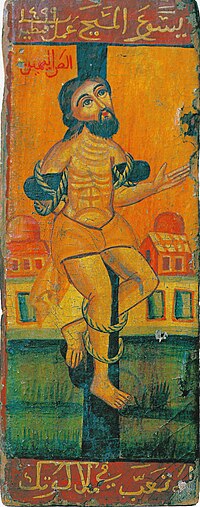
Back ديسماس Arabic ديماس ARZ Dimes el Bon Lladre Catalan Svatý Dismas Czech Dismas German Ευγνώμων ληστής Greek Dimas Esperanto Buen Ladrón Spanish Patukahetseja varas Estonian دیسماس Persian
Dismas the Good Thief | |
|---|---|
 15th-century Arab Christian Icon of Saint Dismas from the Berlin State Museum, reading "Jesus, remember me when you come into your kingdom". | |
| First Saint | |
| Born | Galilee, Herodian Kingdom of Judea, Roman Empire |
| Died | c. 30–33 AD Golgotha Hill outside Jerusalem, Judea, Roman Empire (today Israel) |
| Cause of death | Crucifixion |
| Venerated in | Catholic Church Eastern Orthodox Church Oriental Orthodox Church[1] |
| Canonized | c. 30–33 AD, Golgotha Hill outside Jerusalem by Jesus Christ[2] |
| Major shrine | Church of Saint Dismas the Good Thief, Dannemora, New York, United States |
| Feast | 25 March (Roman Catholic) Good Friday (Eastern Orthodox) |
| Attributes | |
| Patronage | Prisoners (especially condemned) Funeral directors Repentant thieves Merizo, Guam San Dimas, Mexico |
The Penitent Thief, also known as the Good Thief, Wise Thief, Grateful Thief, or Thief on the Cross, is one of two unnamed thieves in Luke's account of the crucifixion of Jesus in the New Testament. The Gospel of Luke describes him asking Jesus to "remember him" when Jesus comes into his kingdom. The other, as the impenitent thief, challenges Jesus to save himself and both of them to prove that he is the Messiah.
He is officially venerated in the Catholic Church. The Roman Martyrology places his commemoration on 25 March, together with the Feast of the Annunciation, because of the ancient Christian tradition[3] that Christ (and the penitent thief) were crucified and died exactly on the anniversary of Christ's incarnation.
He is given the name Dismas in the Gospel of Nicodemus and is traditionally known in Catholicism as Saint Dismas[4] (sometimes Dysmas; in Spanish and Portuguese, Dimas). Other traditions have bestowed other names:
- In Coptic Orthodox tradition and the Narrative of Joseph of Arimathea, he is named Demas.[5][6]
- In the Codex Colbertinus, he is named Zoatham or Zoathan.[7]
- In the Arabic Infancy Gospel, he is named Titus.[8]
- In Russian Orthodox tradition, he is named Rakh (Russian: Рах).[9]
- ^ "How was the Penitent Thief saved without baptism? - Comparative Theology | St-Takla.org". st-takla.org.
- ^ "Saint Dismas – Saint Dismas".
- ^ Holweck, Frederick George (1907). . In Herbermann, Charles (ed.). Catholic Encyclopedia. Vol. 1. New York: Robert Appleton Company.
- ^ Lawrence Cunningham, A brief history of saints (2005), page 32.
- ^ Gabra, Gawdat (2009). The A to Z of the Coptic Church. Lanham, MD: Scarecrow Press. p. 120. ISBN 9780810870574.
- ^ Ehrman, Bart; Plese, Zlatko (2011). The Apocryphal Gospels: Texts and Translations. New York: Oxford University Press. p. 582. ISBN 9780199732104.
a man named demas.
- ^ Metzger, Bruce M.; Ehrman, Bart D. (2005). The Text of the New Testament: Its Transmission, Corruption, and Restoration (4th ed.). Oxford: Oxford University Press. p. 270. ISBN 978-019-516667-5.
- ^ "Ante-Nicene Fathers/Volume VIII/Apocrypha of the New Testament/The Arabic Gospel of the Infancy of the Saviour". Wikisource. 19 April 2009. Retrieved 28 December 2021.
- ^ Renate Gerstenlauer, The Rakh Icon: Discovery of its True Identity, Legat Verlag, 2009 (ISBN 978-3932942358). Cited at "The Repentant Thief Who?". Icons and their interpretation. 17 December 2011. Retrieved 26 April 2014.